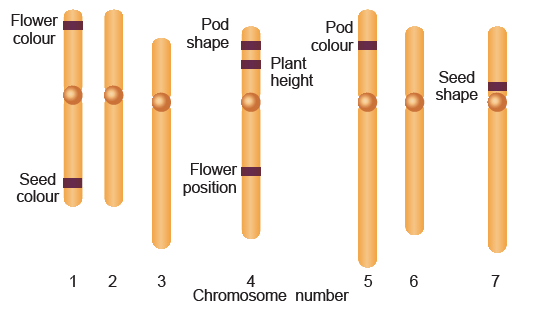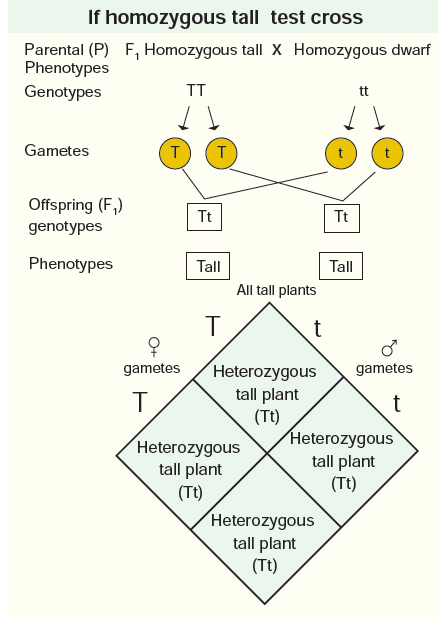Introduction to Mendelism
Mendelism refers to the principles of heredity formulated by Gregor Johann Mendel through his experiments on plant hybridization. These principles laid the groundwork for modern genetics, earning Mendel the title “Father of Genetics.” His systematic study of the inheritance of traits in pea plants revealed fundamental laws that govern genetic inheritance.
Father of Genetics – Gregor Johann Mendel (1822 – 1884)
Biography and Contributions
Gregor Johann Mendel was born on July 22, 1822, in Heinzendorf Silesia (now Hyncice, Czechoslovakia). After completing his education in botany, physics, and mathematics at the University of Vienna, Mendel joined the monastery of St. Thomas at Brunn, Austria. His role as a teacher allowed him to conduct groundbreaking experiments on pea plants in the monastery garden. Between 1856 and 1863, Mendel conducted hybridization experiments that led to the discovery of the laws of inheritance.
Key Achievements of Mendel
Mendel’s success can be attributed to several factors:
- Application of mathematics and statistical methods to biological experiments.
- Meticulous planning and execution of experiments, with large sample sizes and detailed records.
- Use of pure-breeding lines and controlled crosses to ensure reliable results.
Mendel’s Experimental System – The Garden Pea
 >
>Why Mendel Chose the Pea Plant (Pisum sativum)
Mendel selected the garden pea for his experiments due to its:
- Annual growth cycle and distinct contrasting traits controlled by single genes.
- Natural tendency for self-fertilization, with the possibility of cross-fertilization for hybridization.
- Large flowers, which made it easier to perform emasculation and pollination.
Mendel’s Experiments on Pea Plants
Mendel’s Particulate Theory of Inheritance
Mendel proposed the Particulate Theory, which suggests that traits are inherited as discrete units or factors, now known as genes. He worked with true-breeding lines, meaning plants that consistently passed specific traits to their offspring. Mendel’s experiments involved both self-pollination and cross-pollination to study the inheritance patterns of these traits.
Mendel’s First Law: Law of Dominance
Mendel’s first law states that traits are controlled by pairs of factors (alleles), with one allele being dominant and the other recessive. In a monohybrid cross (cross involving a single trait), the dominant trait appears in the F1 generation, while the recessive trait reappears in the F2 generation in a 3:1 ratio.
Mendel’s Second Law: Law of Segregation
According to the Law of Segregation, during gamete formation, the two alleles for each trait separate so that each gamete receives only one allele. This explains why traits do not blend and why the recessive trait reappears in the F2 generation.
 >
>Monohybrid Cross Example
Mendel studied the inheritance of plant height by crossing tall and dwarf pea plants. The F1 generation consisted entirely of tall plants. When these plants were self-pollinated, the F2 generation showed a 3:1 ratio of tall to dwarf plants, confirming the Law of Dominance and the Law of Segregation.
 >
> >
>Reciprocal Crosses
Definition and Significance
A reciprocal cross involves reversing the traits of the parent plants in a genetic cross. Mendel conducted reciprocal crosses between tall and dwarf pea plants and found that the results were consistent, indicating that the traits were not sex-dependent.
Mendel’s Analytical and Empirical Approach
Mendel’s Scientific Rigor
Mendel’s approach involved selecting two contrasting traits for each character. He meticulously recorded his observations, concluding that traits segregate randomly into gametes. His experiments established a 3:1 ratio in the F2 generation, leading to the formulation of the Law of Segregation and the concept of alleles.
Test Cross
Purpose and Procedure
A test cross involves crossing an individual with an unknown genotype with a homozygous recessive individual. Mendel used this method to determine whether a tall pea plant was homozygous (TT) or heterozygous (Tt) by crossing it with a dwarf plant (tt). The results allowed Mendel to predict the genotype of the test organism.
 >
> >
>Back Cross
Back cross is a cross of F1 hybrid with any one of the parental genotypes. The back cross is of two types; they are dominant back cross and recessive back cross.
- It involves the cross between the F1 offspring with either of the two parents.
- When the F1offsprings are crossed with the dominant parents all the F2 develop dominant character and no recessive individuals are obtained in the progeny.
- If the F1 hybrid is crossed with the recessive parent individuals of both the phenotypes appear in equal proportion and this cross is specified as test cross.
- The recessive back cross helps to identify the heterozygosity of the hybrid.
Dihybrid Cross
Law of Independent Assortment
Mendel’s dihybrid cross studied the inheritance of two different traits simultaneously. For example, he crossed pea plants with round yellow seeds (RRYY) with those having wrinkled green seeds (rryy). The F2 generation exhibited a 9:3:3:1 phenotypic ratio, leading to the Law of Independent Assortment, which states that alleles for different traits assort independently during gamete formation.
In dihybrid cross, two characters (colour and shape) are considered at a time. Mendel considered the seed shape (round and wrinkled) and cotyledon colour (yellow & green) as the two characters. In seed shape round (R) is dominant over wrinkled (r) ; in cotyledon colour yellow (Y) is dominant over green (y).
 >
> >
>Hence the pure breeding round yellow parent is represented by the genotype RRYY and the pure breeding green wrinkled parent is represented by the genotype rryy. During gamete formation the paired genes of a character assort out independently of the other pair. During the F1 x F1 fertilization each zygote with an equal probability receives one of the four combinations from each parent.resultant gametes thus will be genetically different and they are of the following four types:
1) Yellow round (YR) – 9/16
2) Yellow wrinkled (Yr) – 3/16
3) Green round (yR) – 3/16
4) Green wrinkled (yr) – 1/16
These four types of gametes of F1 dihybrids unite randomly in the process of fertilization and produce sixteen types of individuals in F2 in the ratio of 9:3:3:1
Significance of Independent Assortment
The Law of Independent Assortment contributes to genetic diversity by allowing various combinations of alleles to occur in the offspring. This genetic variation is crucial for evolution.The Law of Segregation is concerned with alleles of one gene but the Law of Independent Assortment deals with the relationship between genes.
Extensions of Mendelian Genetics
Beyond Simple Inheritance Patterns
While Mendel’s principles form the foundation of genetics, modern genetics has revealed more complex patterns of inheritance, such as incomplete dominance, codominance, and polygenic inheritance. These extensions demonstrate that the interactions between genes can produce a wide range of phenotypes.
Sample Questions and Answers
Q1: Who is known as the Father of Genetics and why?
A1: Gregor Johann Mendel is known as the Father of Genetics because he discovered the basic principles of heredity through his experiments with pea plants, which laid the foundation for modern genetics.
Q2: What are Mendel’s Laws of Inheritance?
A2: Mendel proposed two laws of inheritance:
- Law of Dominance: In a pair of alleles, one is dominant, and the other is recessive.
- Law of Segregation: During gamete formation, the two alleles for a trait separate, ensuring that each gamete carries only one allele.
Q3: How did Mendel’s dihybrid cross contribute to our understanding of genetic inheritance?
A3: Mendel’s dihybrid cross led to the Law of Independent Assortment, which explains how alleles of different genes assort independently during the formation of gametes, contributing to genetic diversity.
Q4: What is a test cross, and why is it important?
A4: A test cross involves crossing an individual with an unknown genotype with a homozygous recessive individual. It helps determine whether the unknown genotype is homozygous dominant or heterozygous.
Q5: Explain the significance of Mendel’s choice of the garden pea (Pisum sativum) for his experiments.
A5: Mendel chose the garden pea because it had clear contrasting traits controlled by single genes, a short life cycle, and the ability to self-fertilize. These characteristics made it an ideal organism for studying inheritance patterns.



